We have a copy (offered by Habib and Clement) of this magazine at Xinchejian if you want to read it.
]]>October 30th, 2011 § 2 comments § permalink
We have a copy (offered by Habib and Clement) of this magazine at Xinchejian if you want to read it.
]]>October 29th, 2011 § 0 comments § permalink
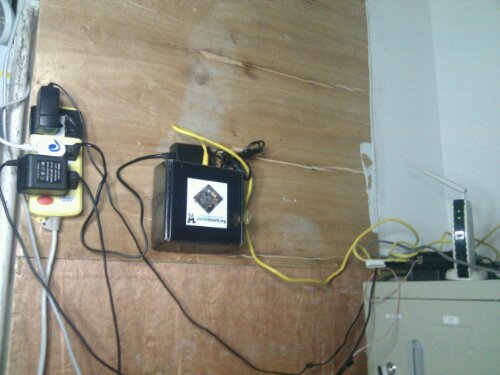
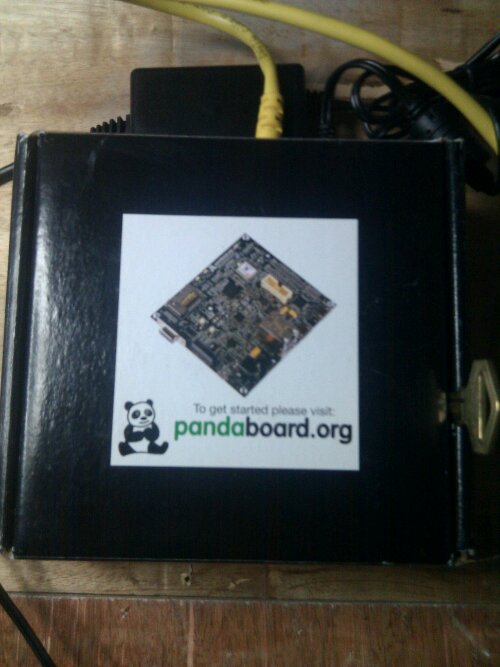
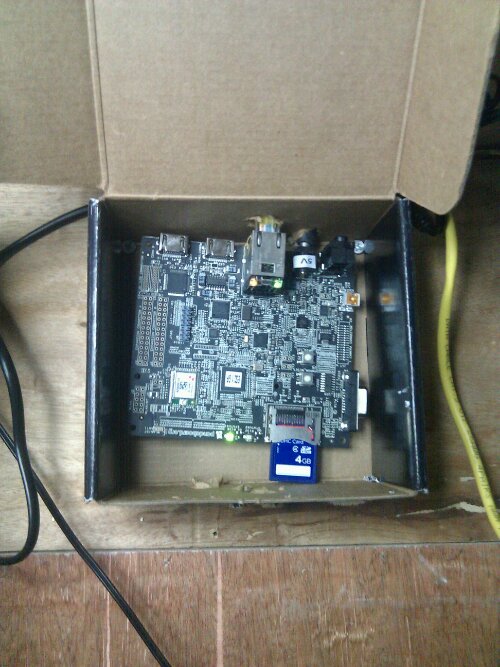 For more information, check our wiki.]]>
For more information, check our wiki.]]>
October 29th, 2011 § 4 comments § permalink
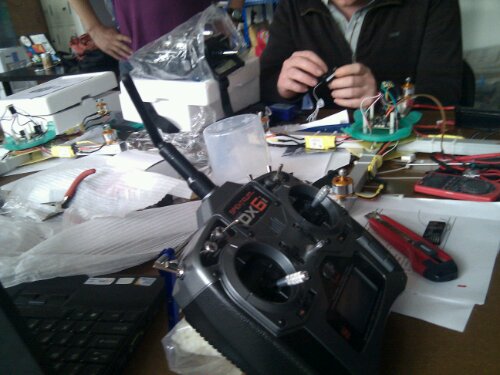
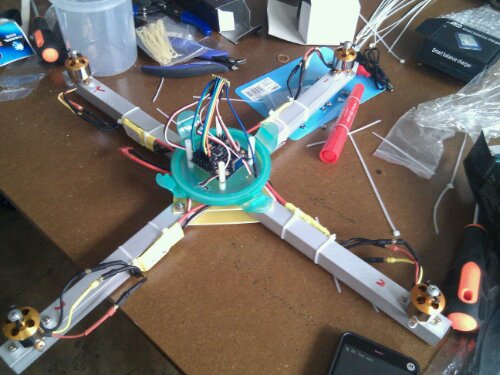
Building an army of inexpensive quadcopters…
]]>October 27th, 2011 § 0 comments § permalink
Planning the trip Since I had a round trip ticket to the US east coast for the 100 Year Starship Study Symposium, me and Min Lin also wanted to visit friends and family in Montreal (Quebec, Canada) on the same trip. While at it, we took the opportunity to visit similar spaces to ours on the east coast between Washington DC to Montreal. As usual, Min Lin did a fantastic job organizing the trip and getting in touch with all the people we visited along the way…
HacDC
Since I had a round trip ticket to the US east coast for the 100 Year Starship Study Symposium, me and Min Lin also wanted to visit friends and family in Montreal (Quebec, Canada) on the same trip. While at it, we took the opportunity to visit similar spaces to ours on the east coast between Washington DC to Montreal. As usual, Min Lin did a fantastic job organizing the trip and getting in touch with all the people we visited along the way…
HacDC HacDC is the first Hackerspace we visited on our trip to the east coast. HacDC is in a neighborhood of historic buildings in Washington DC near Columbia Heights metro station. HacDC was founded in 2008 and they most recently are renting space in the community building of the St Stephen Church (“a very open-minded church”), which host a variety of other non-profit organizations. HacDC is a District of Columbia Non-Profit Corporation. The space is made up of basically two different large rooms: one with the mechanical and electronics tools, the other for computer work.
They have two days of weekly events (Mondays and Thursdays). They also did an Stanford Artificial Intelligence class preparation workshop so I joined in for an improvised review of linear algebra and an overview of Markov chains! They’ve also just received a large donation of lasers and servo-controllable mirrors from X Laser USA. They have a cool idea of doing “stuff” exchange with other Hackerspaces. You fill a box of stuff and send it to them and they fill it back and send it back…
HacDC is the first Hackerspace we visited on our trip to the east coast. HacDC is in a neighborhood of historic buildings in Washington DC near Columbia Heights metro station. HacDC was founded in 2008 and they most recently are renting space in the community building of the St Stephen Church (“a very open-minded church”), which host a variety of other non-profit organizations. HacDC is a District of Columbia Non-Profit Corporation. The space is made up of basically two different large rooms: one with the mechanical and electronics tools, the other for computer work.
They have two days of weekly events (Mondays and Thursdays). They also did an Stanford Artificial Intelligence class preparation workshop so I joined in for an improvised review of linear algebra and an overview of Markov chains! They’ve also just received a large donation of lasers and servo-controllable mirrors from X Laser USA. They have a cool idea of doing “stuff” exchange with other Hackerspaces. You fill a box of stuff and send it to them and they fill it back and send it back… Baltimore Node
The Baltimore Node Hackerspace is a 1700 square feets space with great windows three blocks from the Baltimore Penn Amtrack station. The rent is 1000$USD monthly. The space has existed for 2 years and has between 25 and 30 paying members (50$ per month). OpenHack night weekly has a dozen people doing their projects in the space. The space has homemade work tables and shelves, sofas, microwave, fridge, a full complement of mechanical tools, 3d printer (working!), a foosball table, etc…
Baltimore Node
The Baltimore Node Hackerspace is a 1700 square feets space with great windows three blocks from the Baltimore Penn Amtrack station. The rent is 1000$USD monthly. The space has existed for 2 years and has between 25 and 30 paying members (50$ per month). OpenHack night weekly has a dozen people doing their projects in the space. The space has homemade work tables and shelves, sofas, microwave, fridge, a full complement of mechanical tools, 3d printer (working!), a foosball table, etc… Todd from inceptiontops.com was our guide for the visit of the Baltimore Node hackerspace. He’s a mechanical engineer who’s been doing 3d design for 15 years… He left his job 6 months ago to dedicate himself to do products that he ships all around the USA. Among other things, he sells spinning tops as can be seen in the movie Inception. It takes about one month to get these spinning shapes and so far he’s sold 700 of them. He does a wide variety of things such as necklaces and rings from movies. He has built an “Holocron”, an object from the deleted scenes of Star Wars. He’s also behind an “Han Solo in carbonite” replica and the Shrinking Ray (Ignite Baltimore 8: Todd Blatt – How to use a Shrink Ray for Real). Lots of the smaller parts he sells are made possible by using shapeways.com, a company that specializes in turning 3d CAD shapes into actual real objects in a variety of material (silver, gold-plated, etc). Although he favors Autocad, he sees a big future in web-browser CAD software such as 3dtin.com. He’s really inspired by software generated designs such as those produced by n-e-r-v-o-u-s.com and blog.virtox.net
Todd from inceptiontops.com was our guide for the visit of the Baltimore Node hackerspace. He’s a mechanical engineer who’s been doing 3d design for 15 years… He left his job 6 months ago to dedicate himself to do products that he ships all around the USA. Among other things, he sells spinning tops as can be seen in the movie Inception. It takes about one month to get these spinning shapes and so far he’s sold 700 of them. He does a wide variety of things such as necklaces and rings from movies. He has built an “Holocron”, an object from the deleted scenes of Star Wars. He’s also behind an “Han Solo in carbonite” replica and the Shrinking Ray (Ignite Baltimore 8: Todd Blatt – How to use a Shrink Ray for Real). Lots of the smaller parts he sells are made possible by using shapeways.com, a company that specializes in turning 3d CAD shapes into actual real objects in a variety of material (silver, gold-plated, etc). Although he favors Autocad, he sees a big future in web-browser CAD software such as 3dtin.com. He’s really inspired by software generated designs such as those produced by n-e-r-v-o-u-s.com and blog.virtox.net We also met the owner of the building loadoffun.net, Sherwin. Load of fun is a building with art studios, art gallery, exchanges, theaters, etc. The space has been running for 6 years, much longer than even Sherwin was planning on. Sherwin is very interested in building a LED display on the roof similar to blinkenlights.net. He asked us about doing art exchanges between Baltimore and China; we don’t really have any ideas on how to do help with that, yet.
Hacktory
Visited hacktory.org Hackerspace in Philadelphia. Their 3 rooms is located on the third floor of NTR (Nonprofit Technology Resources), an organization with around 6 full-time employee dedicated to providing IT services to low-income people in Philly. Stephen gave us a visit from NTR; they have a thrift store, classes and process a large number of computers for repairs. Sadly, with the state of the economy, both the funds from the fed and the state have dried up leaving NTR in a precarious situation.
We also met the owner of the building loadoffun.net, Sherwin. Load of fun is a building with art studios, art gallery, exchanges, theaters, etc. The space has been running for 6 years, much longer than even Sherwin was planning on. Sherwin is very interested in building a LED display on the roof similar to blinkenlights.net. He asked us about doing art exchanges between Baltimore and China; we don’t really have any ideas on how to do help with that, yet.
Hacktory
Visited hacktory.org Hackerspace in Philadelphia. Their 3 rooms is located on the third floor of NTR (Nonprofit Technology Resources), an organization with around 6 full-time employee dedicated to providing IT services to low-income people in Philly. Stephen gave us a visit from NTR; they have a thrift store, classes and process a large number of computers for repairs. Sadly, with the state of the economy, both the funds from the fed and the state have dried up leaving NTR in a precarious situation. Hacktory had a free electronic music concert on the Thursday evening we were there with two guys from Holland. They have weekly open house on Tuesday with about three to ten persons coming. Founded 5 years ago (in 2007), they’re in the process of reorganizing the space. They have a variety of workshops such as Arduino workshops, electronics jewelry workshop and testing the new chromatograph. BernieS (aka Ed Cummings, a long-term hacker and ham radio operator), one of the active member that guided us around that evening, was actually the one who originally invited Mitch Altman to HOPE (Hackers On Planet Earth) igniting a lifelong passion. Also there were Gloria, Andrew and Stephanie.
Hacktory had a free electronic music concert on the Thursday evening we were there with two guys from Holland. They have weekly open house on Tuesday with about three to ten persons coming. Founded 5 years ago (in 2007), they’re in the process of reorganizing the space. They have a variety of workshops such as Arduino workshops, electronics jewelry workshop and testing the new chromatograph. BernieS (aka Ed Cummings, a long-term hacker and ham radio operator), one of the active member that guided us around that evening, was actually the one who originally invited Mitch Altman to HOPE (Hackers On Planet Earth) igniting a lifelong passion. Also there were Gloria, Andrew and Stephanie. Hive76
Hive76.org is another Hackerspace in Philly that we got a chance to visit after the free concert at the hacktory.org. They opened in the Spring of 2009. They have an open house every Wednesday and a microcontroller meetup once a month. Yesterday, Thursday, they were hosting the Philadelphia Robotics meeting who are thinking of building a sumo robot for competition.
Hive76
Hive76.org is another Hackerspace in Philly that we got a chance to visit after the free concert at the hacktory.org. They opened in the Spring of 2009. They have an open house every Wednesday and a microcontroller meetup once a month. Yesterday, Thursday, they were hosting the Philadelphia Robotics meeting who are thinking of building a sumo robot for competition. We were welcome to the space by Brendan aka RandomLame, a superbly creative maker who just plunk all his savings to build a beautiful flight simulator cockpit panel that adds tons of realism. He built the whole thing in a intense two weeks, mostly constrained by the time to laser cut the panel. Want your own? He’s selling the ready to play system for 5K$ (3K$ for just the controls). In addition to that, he also makes electronic boxes for classes and beautiful handcrafted boombox that double as luggage (from 250 to 350$USD)! His friend does laser imprinted beef jerky business cards…
Other members have built things like RC controlled quadcopters. Daniel Hugo, another member, is building a space game based on the Unity engine.
New Work City
New Work City, is a coworking space at 412 Broadway (corner canal) in New York city. Comfy, quiet and big with one of the best location in town! We met up with Tony Bacigalupo, the owner of NWC who came to Shanghai last August for a panel on coworking… We mentionned Todd and his product on the Shapeways community and he told us that his roomate worked at the HQ in New York! We took a meeting the same day.
Shapeways
We visited Shapeways headquarters in New York City, an innovative company that has created an online community of people designing objects to be produced on-demand. This lets creative people directly benefit from their design without having to worry about manufacturing, selling and shipping.
[caption id="attachment_1687" align="aligncenter" width="470" caption="Ceramic, metal, plastic"]
We were welcome to the space by Brendan aka RandomLame, a superbly creative maker who just plunk all his savings to build a beautiful flight simulator cockpit panel that adds tons of realism. He built the whole thing in a intense two weeks, mostly constrained by the time to laser cut the panel. Want your own? He’s selling the ready to play system for 5K$ (3K$ for just the controls). In addition to that, he also makes electronic boxes for classes and beautiful handcrafted boombox that double as luggage (from 250 to 350$USD)! His friend does laser imprinted beef jerky business cards…
Other members have built things like RC controlled quadcopters. Daniel Hugo, another member, is building a space game based on the Unity engine.
New Work City
New Work City, is a coworking space at 412 Broadway (corner canal) in New York city. Comfy, quiet and big with one of the best location in town! We met up with Tony Bacigalupo, the owner of NWC who came to Shanghai last August for a panel on coworking… We mentionned Todd and his product on the Shapeways community and he told us that his roomate worked at the HQ in New York! We took a meeting the same day.
Shapeways
We visited Shapeways headquarters in New York City, an innovative company that has created an online community of people designing objects to be produced on-demand. This lets creative people directly benefit from their design without having to worry about manufacturing, selling and shipping.
[caption id="attachment_1687" align="aligncenter" width="470" caption="Ceramic, metal, plastic"] [/caption]
Eyebeam
Eyebeam, an art and technology center in New York city at 21st and 10th. They have a panel on “Internet economy: porn, labor, banking”. I’ll let you guess which one of those piqued my curiosity! We dragged all our luggage across half of the island to get here… The talks:
[/caption]
Eyebeam
Eyebeam, an art and technology center in New York city at 21st and 10th. They have a panel on “Internet economy: porn, labor, banking”. I’ll let you guess which one of those piqued my curiosity! We dragged all our luggage across half of the island to get here… The talks:
 NYC Resistors
The next day we checked out the NYC Resistors hackerspace in Brooklyn, a big space at the fourth floor of an old factory in Brooklyn. The day we were there was their monthly laser CNC class that we sadly missed by half an hour… They have craft night on Thursday. Monday evening is “Lazzzzor night” where operators help makers use the laser cutter. The space was started in part by the same people behind Makerbot who’s office is just next door.
NYC Resistors
The next day we checked out the NYC Resistors hackerspace in Brooklyn, a big space at the fourth floor of an old factory in Brooklyn. The day we were there was their monthly laser CNC class that we sadly missed by half an hour… They have craft night on Thursday. Monday evening is “Lazzzzor night” where operators help makers use the laser cutter. The space was started in part by the same people behind Makerbot who’s office is just next door. Alpha One Labs (231 Norman, room 312, Brooklyn)
Alpha One Labs, another hackerspace in Brooklyn. They were having their first robotics meetup watching Google IO cloud robotics video. Sean and his wife are the founders and their homeschooled children use the space to learn. The space is 700 square feet at 1200$ a month. 43 members paying 40$ each per month to be members.
SONIA and ETSMTL
At our university visiting the student club that me and Min Lin co-founded ten years ago: SONIA , the autonomous robot submarine club. We’re very proud that they finished 1st at the international competition this summer thanks to the technical leadership of the 2011 captain Kevin Larose who worked hard machining most of the mechanical parts and designing a majority of the electronics boards. The robot is a sophisticated and complex piece of hardware with a very sophisticated software interface that can control the robot in real-time or replay logs.
Alpha One Labs (231 Norman, room 312, Brooklyn)
Alpha One Labs, another hackerspace in Brooklyn. They were having their first robotics meetup watching Google IO cloud robotics video. Sean and his wife are the founders and their homeschooled children use the space to learn. The space is 700 square feet at 1200$ a month. 43 members paying 40$ each per month to be members.
SONIA and ETSMTL
At our university visiting the student club that me and Min Lin co-founded ten years ago: SONIA , the autonomous robot submarine club. We’re very proud that they finished 1st at the international competition this summer thanks to the technical leadership of the 2011 captain Kevin Larose who worked hard machining most of the mechanical parts and designing a majority of the electronics boards. The robot is a sophisticated and complex piece of hardware with a very sophisticated software interface that can control the robot in real-time or replay logs.

 The main hall of ETS (“Ecole de technologies superieures”) is full of student clubs projects that place well in international competitions against some of the best universities in the world year after year. Wind powered car, cement canoe, human-powered submarine, solar boat, ultra high efficiency car, etc.
The main hall of ETS (“Ecole de technologies superieures”) is full of student clubs projects that place well in international competitions against some of the best universities in the world year after year. Wind powered car, cement canoe, human-powered submarine, solar boat, ultra high efficiency car, etc. FOULAB (999 du Collège, 3rd floor, near métro St-Henri, Montreal).
Foulab is the first Montreal Hackerspace… Turns 3 years old next November 20th, 1800 square feets. Various projects: boombike, twitter Teletext, 3d persistence of vision, soon to be cluster, computer security. They’re very focused on computer security and organize the yearly Recon event.
FOULAB (999 du Collège, 3rd floor, near métro St-Henri, Montreal).
Foulab is the first Montreal Hackerspace… Turns 3 years old next November 20th, 1800 square feets. Various projects: boombike, twitter Teletext, 3d persistence of vision, soon to be cluster, computer security. They’re very focused on computer security and organize the yearly Recon event. ]]>
]]>
October 27th, 2011 § 1 comment § permalink
100 Year Starship Study Symposium in Orlando, Florida October 30th to September 2nd. The goal of the 100 Year Starship Study is to create an organization with a small amount of seed money (one-time half a million dollars US) that can lead the development of an interstellar starship within the next century. At the symposium, I joined Tan Huei Ming and Eddie Cho, both at the National University of Singapore. They had independently submitted a document to the 100 Year Starship Study and I had met them in person while participating in DARPA “The Future of Make” executive panel in Singapore.
Initiated by Mr David L. Neyland (DARPA tactical technology office) and Dr Peter Worden (Director, NASA Ames Research Center). As a major driver of the whole endeavor, Mr Neyland kicked off the symposium and introduced the keynote speaker: Ariel Waldman of spacehack.org with her talk “Hacking Space Exploration”. [caption id="" align="aligncenter" width="300" caption="Ariel Waldman and me"]
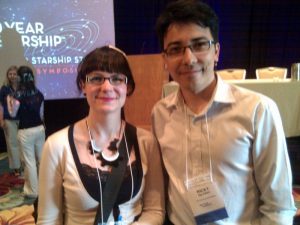 [/caption]
Ariel is a graphic designer that has always been fascinated by space and she talked about how doing something changes how we see something and that we don’t need to be an astronaut to do space stuff… don’t even need to be at NASA to explore stuff! “. We should not let lack of knowledge prevent people to send stuff into space: we need to make technology disruptively accessible. This can be done through competitions and communities such as Google Lunar X Prize, Lockeed Martin’s Aerospace Exploration, university rover challenge, Galaxy Zoo.
There was many talks on many tracks throughout the 3 days of the symposium, all very informative and interesting.
[caption id="attachment_1675" align="aligncenter" width="470" caption="A sample of the talks"]
[/caption]
Ariel is a graphic designer that has always been fascinated by space and she talked about how doing something changes how we see something and that we don’t need to be an astronaut to do space stuff… don’t even need to be at NASA to explore stuff! “. We should not let lack of knowledge prevent people to send stuff into space: we need to make technology disruptively accessible. This can be done through competitions and communities such as Google Lunar X Prize, Lockeed Martin’s Aerospace Exploration, university rover challenge, Galaxy Zoo.
There was many talks on many tracks throughout the 3 days of the symposium, all very informative and interesting.
[caption id="attachment_1675" align="aligncenter" width="470" caption="A sample of the talks"] [/caption]
I tried focusing on those that could help guide our developments in the short-term (next decade):
[/caption]
I tried focusing on those that could help guide our developments in the short-term (next decade):
October 26th, 2011 § 0 comments § permalink
This week at XinCheJian – Ricky and Min Lin have come home from their North American tour of hackerspaces – from DC to Montreal. Tonight catch up with Ricky as he shares their journey including the stop off for the 100yr Starship project.
This coming weekend is Robo-racing, best time to finish your autonomous robot is this evening (or Saturday before the race), race on Saturday is free to enter and free to watch, participants are asked to arrive at 1pm for setup, racing will start at 2pm loose.
For the lock picking research group, it’s time to grind your own picks, Michael has printed out the templates so come see and come do, it’s time to have your own tools of the trade.
EL Wire introduction, come see the coolest thing since sliced bread, Just in time for Halloween – readily available in shanghai, weave/thread/stick/sow this stuff into clothing to create futuristic attire.
Please remember that this is a free event, with no set format, if this will be your first time attending a Wednesday meetup start by introducing yourself to people and finding common interests.
]]>October 22nd, 2011 § 0 comments § permalink
]]>
October 22nd, 2011 § 1 comment § permalink
Bhut Jolokia peppers on Taobao and start them today. The pepper is rated at 1,000,000 SHU. It will be fun to grow them and probably more fun to see someone eat them! 😉

Location:安西路,上海市,中国
]]>October 21st, 2011 § 0 comments § permalink
October 11th, 2011 § 0 comments § permalink